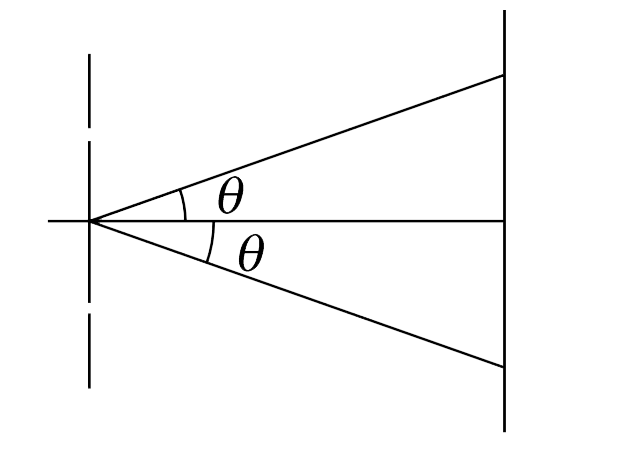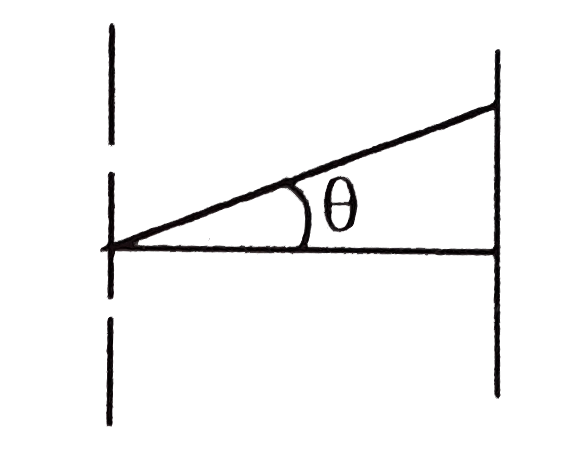Two slits are separated by 0.320 mm. A beam of 500 nm light strikes the slits, producing an interference pattern. Determine the number of maxima observed in the angular range −30.0∘<θ<30.0∘.
At 30.0∘,dsinθ=mλ
(3.20×10−4m)sin30.0∘=m(500×10−9m)
So, m=320
There are 320 maxima ot the right, 320 to the left, and one for
m=0 straight ahead.
Therefore, there are 641 maxima.
Topper's Solved these Questions
- WAVE OPTICSBOOK - CENGAGE PHYSICSCHAPTER - WAVE OPTICSEXERCISE - Subjective
11 Videos
- WAVE OPTICSBOOK - CENGAGE PHYSICSCHAPTER - WAVE OPTICSEXERCISE - Single Correct
128 Videos
- WAVE OPTICSBOOK - CENGAGE PHYSICSCHAPTER - WAVE OPTICSEXERCISE - Exercise 2.1
12 Videos
- THERMODYNAMICSBOOK - CENGAGE PHYSICSCHAPTER - THERMODYNAMICSEXERCISE - QUESTION BANK
34 Videos
- WAVESBOOK - CENGAGE PHYSICSCHAPTER - WAVESEXERCISE - QUESTION BANK
38 Videos
Similar Questions
In a Young's double slit experiment, the slits are placed 0.320 mm apart. Light of wavelength λ=500 nm is incident on the slits. The total number of bright fringes that are observed in the angular range −30∘≤θ≤30∘ is :
View SolutionIn Young’s double-slit experiment, the separation between two slits is d = 0.32 mm and the wavelength of light used isλ=5000∘A. Find the number of maxima in the angular range−sin−1(0.6)≤θ≤sin−1(0.6)

View Solution
Knowledge Check
Two slits separated by 0.33mm.A beam of 500nm light strikes the slits producing an interference pattern.Tegh number of maxiam observed in the angular angle range−30∘<θ<30∘
 A300B150C599D149
A300B150C599D149In Yonung's double-slit experiment, two slits which are separated by 1.2 mm are illuminated with a monochromatic light of wavelength 6000Å The interference pattern is observed on a screen placed at a distance of 1 m from the slits. Find the number of bright fringes formed over 1 cm width on the screen.
A25B12C15D20
In Young's double-slit experiment, monochromatic light of wavelength 630 nm illuminates the pair of slits prodcues an interference pattern in which two consecutive bright fringes are separated by 8.1 mm. Another source of monochromatic light produces the interference pattern in which the two consecutive bright fringes are separated by 7.2 mm. Find the wavelength of light for the second source.
What is the effect on the interference fringes if the monochromatic source is replaced by a source of white light?
View SolutionLaser light of wavelength 640 nm incident on a pair of slits produces an interference patterns in which the bright fringes are separated by 8.1 mm. A second light produces an interference pattern in which the fringes and separated by 7.2 mm. Calculate the wavelength of the second light.
View SolutionLaser light of wavelength 630 nm incident on a pair of slits produces an interference pattern in which the bright fringes are separated by 8.1 mm. A second laser light produces an interference pattern in which the fringes are separated by 7.2 mm. Calculate the wavelength of the second light.
View SolutionIn Young's double-slit experiment,, monochromatic light of wavelength 630 nm illuminates the pair of slits and produces an interference pattern in which two consecutive bright fringes are separated by 8.1mm. Another source of monochromatic light produces the interference pattern in which the two consecutive bright fringes are separated by7.2 mm. find the wavelength of light from the second source.
What is the effect on the interference fringes if the monochromatic source is replaced by a source of white light ?
View SolutionLaser light of wavelength 630 mm incident on a pair of slits produces as interference pattern in which the bright fringes are separated by 8.1 mm. A second light produces an interference pattern in which the fringes are separated by 7.2 mm. Calculate the wavelength of the second light.
View SolutionTwo slits 4.0×10−6 m apart are illuminated by light of wavelength 600nm . What is the highest order fringe in the interference pattern?
View Solution
